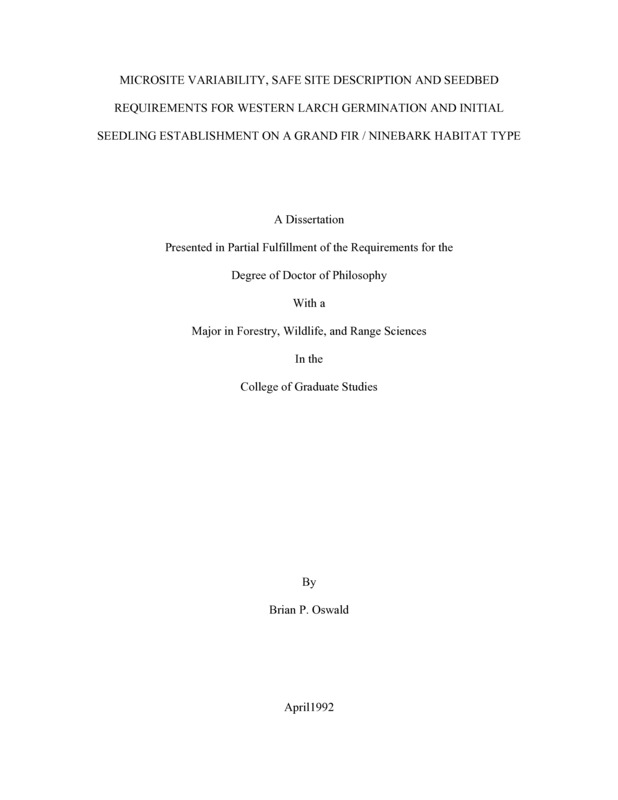PDF PREVIEW
Microsite Variability, Safe Site Description and Seedbed Requirements for Western Larch Germination and Initial Seedling Establishment on a Grand Fir/Ninebark Habitat Type Item Info
- Title:
- Microsite Variability, Safe Site Description and Seedbed Requirements for Western Larch Germination and Initial Seedling Establishment on a Grand Fir/Ninebark Habitat Type
- Creator:
- Oswald, Brian P.
- Date Created:
- 1992-04-01
- Description:
- Forest floor heterogeneity is an important factor in shaping community diversity and species richness. We measured small scale micro site heterogeneity in an Abies grandis/Physocarpus malvaceus habitat type in northern Idaho. Micro sites were classified on October 1987 with three locator (site, line, sampling point) and eight descriptor (duff depth, litter cover, stick number, vegetative shading, soil surface roughness, presence of vegetation and moss) categorical variables. A burning treatment was applied to half of the sampling points. Classification of micro site types (distinct combinations of descriptor variables) was performed prior to treatment, following treatment, and one year after treatment (1988). Variation was investigated using principle component analysis (PCA) and chi-square analysis. Burning reduced micro site variability, especially single-occurring micro site types, but the reduction was short lived. The micro site type most common in all three measurements (<5 cm duff depth, 21-50% litter cover, 0 sticks, moss, shading, vegetation) was reduced in frequency of occurrence with burning. Locator variables accounted for 98% of the variation. If locator vegetation were the primary descriptors accounting for 73-84% of the micro site type variation. Western larch (Larix occidentalis) seeds were distributed after burning treatment (seven on each sample point), and the germinations (radicle emerging from seed), germinants (radicle entering forest floor and needles developing) and seedling (seed cap off and needles visible) numbers tracked over two growing seasons. Germinations (741) and germinants (656) from 17,500 seeds were found on a wide variety of micro site types for representing “safe sites” (the zone with the characteristics for germination and seedling development to occur) for these stages of development. Safe site requirements became more specific as the seedling developed, with 47 seedling surviving on 33 micro sites types at the end of the first growing season. Significant descriptor variables and interactions were identified from regression; analysis produces high (R2 = 0.75) predictability at the end of the first growing season for initial seedling establishment. Safe factors not measured in this study are critical for germination of western larch. The effects of shading, burning and mechanical seedbed treatment on western larch germination and first year establishment were also assessed. Sixteen 0.74 m2 -plots were established in 1987 and 1988 and 150 western larch seeds (100 expected to germinate) distributed of randomly applied seedbed treatments (burning or mechanical, mineral soil or duff, shaded or non-shaded, caged or non-caged to protect from predation). Germination was significantly greater on caged units than on uncaged units by mid-season due to seed predation on uncaged units. Shading was not a significant factor. Mortality of seedlings, most likely caused by a dry period with high temperatures from July to mid-August, resulted in no significant differences in seedling numbers between seedbed treatments by mid-August.
- Document Type:
- Thesis
- Library Call Number:
- SD144.I2079 1992
- Subjects:
- soils microsite microclimate heterogeneity species richness community diversity grand fir abies grandis ninebark silviculture
- UIEF Unit:
- UIEF
- Location:
- UIEF
- Latitude:
- 46.869607
- Longitude:
- -116.733856
- Department:
- Department of Forest Resources
- Type:
- Text
- Format:
- application/pdf
Source
- Preferred Citation:
- "Microsite Variability, Safe Site Description and Seedbed Requirements for Western Larch Germination and Initial Seedling Establishment on a Grand Fir/Ninebark Habitat Type", UIEF Research Exchange, University of Idaho Library Digital Collections, https://www.lib.uidaho.edu/digital/uief/items/uief_0058.html
Rights
- Rights:
- In copyright, educational use permitted.
- Standardized Rights:
- http://rightsstatements.org/vocab/InC-EDU/1.0/

